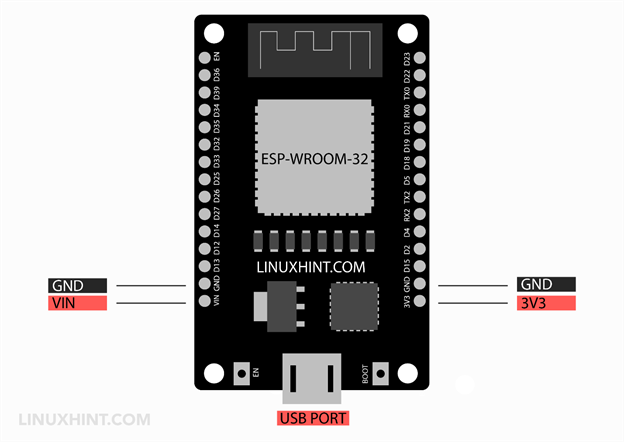ESP32 Voltage Pins
The ESP32 can be powered using several different input sources. The ESP32 can be powered through two primary pins: the VN (Vin) pin and the 3V3 (3.3V) pin. The main source of powering ESP32 is using the USB cable. In ESP32, a USB port is preferred for powering the board and it acts as the primary power source where we don’t have any external voltage available. The other two sources are dependent on external regulated power sources.
The ESP32 is equipped with a 3.3V voltage regulator that can receive input from two sources: the USB port and the VN pin. The ESP32’s input of 5V is converted to 3.3V by a voltage regulator. When the Vin pin is connected to an external power supply, the ESP32 board can operate within a range of 5V to 12V.
There are three voltage pins in ESP32:
- 3V3 PIN
- 5V/VN PIN
- GND PIN
3V3 Pin
The 3V3 pin is one of the most used voltage pins on the ESP32 board. The 3V3 pin is the main source of power for the ESP32 pin as it is the operating voltage for this board. It provides a regulated 3.3V to various components on the board. The 3V3 pin can also be used to power external devices, such as sensors and LEDs, provided they require a voltage output of 3.3V.
5V/VN Pin
The 5V pin or VN pin on the ESP32 board provides a regulated voltage output of 5V, which is used to power external components that require a voltage output of 5V. This pin is connected to the onboard voltage regulator, which regulates the voltage supplied to the pin, ensuring stable voltage levels.
The ESP32 is not 5V tolerant. However, we can power the ESP32 Dev board with 5V in the VN pin. The ESP32 LDO regulator converts the voltage from 5V to 3.3V. We can also scale down the 5V to 3.3V using an external voltage divider and an op-amp circuit. This 5V pin can also be used as a power source for external devices when the ESP32 board is USB-powered.
Note: The VN pin works as both an input and output source. However, it’s not recommended to use the 3V3 pin as a power input because any increase in voltage could result in excessive current flow from the output terminal of the LDO regulator (AMS1117) to the input, which may permanently damage the ESP32 voltage regulator. Nevertheless, a constant 3.3V supply can be used.
Do not provide more than 9V to the VN pin since the ESP32 only requires 3.3V for operation, and any excess voltage will dissipate as heat.
GND Pin
The GND pin on the ESP32 board is used as a ground reference for the circuit. It is connected to the ground plane of the board and provides a reference voltage level for the components on the board. It is the point of zero potential and provides a stable and reliable reference for the circuit’s electrical signals.
Conclusion
Voltage pins in ESP32 boards are responsible for regulating the power supply to the board. ESP32 has primarily three main voltage pins that are VN, 3V3 and GND. VN and 3V3 pins can power the ESP32 board and the GND pin act as a reference point for ESP32 peripherals and GPIO pins. Read the article to get more explanation on all these three power pins of ESP32.

